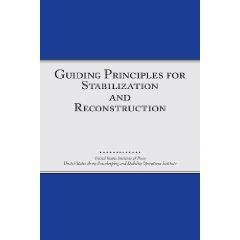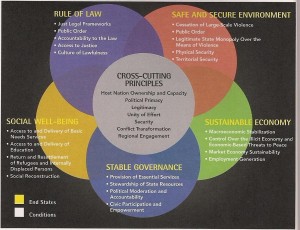
At its most fundamental this is without question the most extraordinary sensible and useful synthesis of all possible documents devoted to the subject, offering up a truly remarkable–just an amazing–framework for study and for planning.
The publisher failed to make full use of the Amazon tools for showing the Table of Contents at a minimum, and this error should be corrected immediately. Inside the Book is also recommended. I would normally reduce the book to four stars for its failure include all those outside the “traditional” national security community; for its lack of an index, and for its ignorance of most relevant books outside the narrow circle of stabilization & reconstruction groupies. However, this is such an incredibly gifted, intelligent, and meticulous presentation of vitally important information that I leave it at six star special, beyond five stars.
Still, to not be able to see in an index every page for key words like “water” or “intelligence” is infuriating.
 First, an overview of the contents, vastly more simple than the complex array of information presented in sub-sets of conditions, guidance, approach, and then elements.
First, an overview of the contents, vastly more simple than the complex array of information presented in sub-sets of conditions, guidance, approach, and then elements.
+ Introduction
+ Strategic Framework for Stabilization and Reconstruction
+ Cross-Cutting Principles
+ High-Level Trade-Offs, Gaps, and Challenges
+ Fundamentals of a Comprehensive Approach
+ End States
—Safe and Secure Environment
—Rule of Law
—Stable Governance
—Sustainable Economy
—Social Well-Being
+ Appendices
A. Resources List
B. Participants in Review Process
C. Summary of Strategic Frameworks Surveyed
D. Snapshot of COmpoments from Overarching Resources
E. Acronyms and Glossary of Selected Key Terms (incomplete, another annoyance that needs to be corrected)
I could spend a year reading and re-reading this book and still not master it in detail. This is one of those books that must become like a Bible, read and re-read, consulted at every turn. It should become the standard “Ref A” for all government and academic and non-governmental training programs, should be translated into French immediately, and offered to regional organizations for adaptation or adoption and translation in prominent regional languages. The placement of the notes at the foot of each page is exactly right and most valuable. A corresponding website where the book can be searched electronically, with electronic links to each reference and a wiki for development new knowledge, is recommended and surely within the capabilities of the US Institute of Peace (USIP) that has given us this work.
There are nuggets at every turn of the page, but sadly, every turn of the phrase reminds me of Winston Churchill's famous dictum, “The Americans always do the right thing–they just try everything else first.” This is the book the American government has not read, nor will it ever, absent an honest non-partisan Congress, an honest non-partisan White House, and a combination of a national open source agency such as Congressman and future Senator Rob Simmons and I propose in THE SMART NATION ACT: Public Intelligence in the Public Interestand a National Strategy Center such as General Tony Zinni proposes in The Battle for Peace: A Frontline Vision of America's Power and Purpose and David Abshire first alluded to in his epic Preventing World War III: A Realistic Grand Strategy. More recently of course we have Colin Gray's Modern Strategy and Max Manwaring seminal edited work, The Search for Security: A U.S. Grand Strategy for the Twenty-First Century.
On the subject of intelligence (decision-support) the book impresses me with its many thoughtful references throughout that acknowledge on the one hand that “Intelligence is not a formal or acknowledged part of Stabilization & Reconstruction missions,” and on the other hand, across every condition of this book, that information-sharing and sense-making–intelligence analysis for decision-support are vital to achieving success.
The team putting this book together surprises me in the most favorable manner for its understanding of how security rests on shared information, on how intelligence is NOT a “dirty word” bur rather essential for achieving every condition that helps achieve every end state for which this book provides guidelines.
The book is properly critical of the military for obsessing on building up security forces (both military and law enforcement) to the exclusion of all else, and the book impresses me by emphasizing the need to vet those being trained, but disappoints in not being current on both the absolute necessity of biometrics for vetting, and what happens when we fail to do so: training the Taliban in Afghanistan and opponents of the lawful government in Iraq.
The entire book is an intelligence requirements list, and while the book fails miserably in isolating intelligence or having any regard for books on intelligence such as Peacekeeping Intelligence: Emerging Concepts for the Future, it could and should be immediately complemented with an intelligence workbook such as might be developed by the new Army Civil Affairs Brigade in partnership with the United Nations (UN) Mission in Iraq and other elements, e.g. Marine Corps Expeditionary Forces.
Years ago a number of us hoped for the US Special Operations Command to be split in two, with a White Hat deputy added. Today we have the Africa Command, but it has failed to achieve the Stabilization & Reconstruction vision or capability, or to move much beyond what this book criticizes: the military has a hammer, every mission is a nail, and we still have ZERO capability to plan, program, or execute “whole of government” anything, much less what General Al Gray called for in his 1989 article, “Global Intelligence Challenges for the 1990's,” when he called for a focus on the Third World, a focus on open sources of information, and a focus on “peaceful preventive measures.”
The book has its moments of naivete, such as expecting the UNto get the mandate right when the UN has failed to execute the recommendations of the Brahimi Report and the current Secretary General appears to have no understand of or appreciation for the findings of the High Level Panel on Threats, Challenges, and Change, whose report, A More Secure World: Our Shared Responsibility–Report of the Secretary-General's High-level Panel on Threats, Challenges and Change, is the single most important document produced at the dawn of the 21st Century–but also the most ignored report.
The book calls for, naturally and advisedly, for civilian primacy, but avoids the raw fact that we have no civilians capable of leading an inter-agency endeavor, much less a multinational endeavor for lack of the culture, the training, or the communications and computing infrastructure. The US lacks a whole of government intelligence capability and is totally devoid of anything to offer in the way of multinational engagement and multinational as well as stabilization and reconstruction decision support, a lack easily remedied [see The Future of OSINT list of references at Phi Beta Iota, the Public Intelligence Blog]. See also the Review category, Stabilization & Reconstruction, with 29 reviews.
The book comes with a poster of the five circles (Cross-Cutting Principles in the middle,) then four colored circles with the highlights for Rule of Law (purple), safe and secure environment (red), social well-being (gold), sustainable economy (green), and stable governance (blue). A copy of that image is at Phi Beta Iota, since Amazon deleted my 350 images in an act of doltish censorship I refuse to post images at Amazon.




